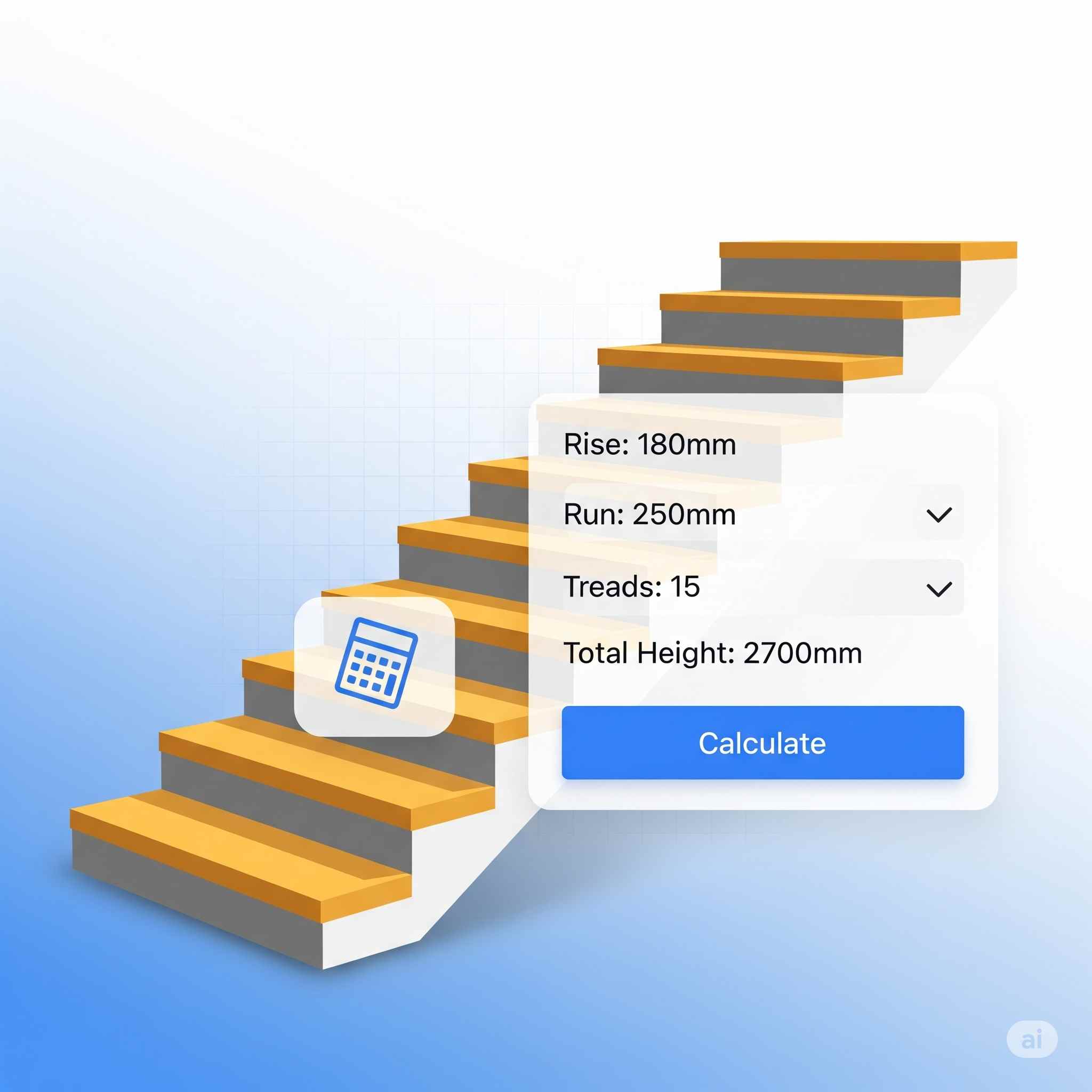Stair Calculator
Calculate the dimensions for your staircase.
Number of Steps
0
Actual Riser Height
0
Total Run
0
Stair Angle
0
Stringer Length
0
Total Material Area
0
Total Estimated Cost
$0
3D Stair Visualization
Click and drag to rotate the stairs.
Staircase Calculation Results
Dimensions are for a total rise of .
| Measurement | Value |
|---|---|
| Number of Steps | |
| Actual Riser Height | |
| Total Run | |
| Stair Angle | |
| Stringer Length | |
| Total Material Area | |
| Total Estimated Cost |

Stair Calculator – Accurate Staircase Design Tool for Builders & DIY Projects
Designing safe, comfortable stairs starts with correct measurements. Our free Stair Calculator helps you calculate riser height, tread depth, total run, stair angle and stringer length — instantly and accurately. Whether you’re an architect, contractor, or DIY homeowner, use this guide and calculator to get code-compliant results quickly.
Why You Need a Stair Calculator
Stairs must be comfortable to walk on and safe to use. Small measurement mistakes — uneven risers, too-shallow treads, or incorrect stringer length — can cause discomfort and increase trip hazards. A stair calculator automates the math and enforces consistency so you avoid common construction errors, estimate materials accurately, and meet local building requirements.
Use the calculator during the planning stage to quickly test multiple design options (different riser heights or tread depths) and compare outcomes for safety, material use, and overall footprint.
How the Stair Calculator Works
The calculator takes simple inputs and returns all essential stair geometry:
- Total rise – the vertical distance from lower floor to upper floor (floor-to-floor height).
- Desired tread depth – the usable depth of each step.
- Preferred or maximum riser height – usually bounded by code.
From those inputs it calculates:
- Number of steps (risers)
- Actual riser height per step
- Total run (horizontal footprint)
- Stair angle/slope
- Stringer length (calculated using the Pythagorean theorem)
The algorithm ensures riser heights are consistent across all steps (critical for safety) and allows you to iterate to meet code limits and spatial constraints.
Key Stair Measurements You Need to Know
Riser Height
The riser is the vertical portion of a step. Typical residential values are 7″–7.75″ (178–197 mm). Consistency is required — all risers should be the same height.
Tread Depth
The tread is the horizontal, walkable surface. Commonly 10″–11″ (254–279 mm) for comfortable steps. Consider nosing (overhang) when measuring tread depth.
Total Run
Total horizontal length the stairs occupy. Calculated as (number of treads × tread depth) + allowances for nosing where applicable.
Stringer Length
The stringer is the diagonal structural member. Compute stringer length using the Pythagorean theorem: stringer = √(total rise² + total run²).
Stair Angle
Stair angle (slope) is determined by rise and run. Comfortable stairs usually fall between 30°–37°. Steeper than that becomes uncomfortable and potentially unsafe.
Step-by-Step: How to Use the Online Stair Calculator
- Measure total rise — from finished floor to finished floor (or subfloor to subfloor depending on build stage).
- Choose a target riser height — pick a value within your local code limits (or let the calculator suggest an optimized riser).
- Enter desired tread depth — consider nosing and finish materials when selecting tread depth.
- Run the calculation — click Calculate to get number of steps, exact riser height, total run, angle and stringer length.
- Review and adjust — if results exceed code limits or the run is too long/short, change tread/riser inputs and recalc.
Pro tip: Keep a digital or printed copy of the calculation to share with carpenters or your building inspector.
Benefits for Builders, Contractors & Homeowners
- Saves time: instantly evaluate different layouts.
- Reduces mistakes: eliminates manual calculation errors.
- Material estimates: calculate stringer lengths and overall dimensions for accurate cutting and ordering.
- Compliance: helps you keep within code limits for riser height and tread depth.
- Confidence for DIYers: removes the guesswork from stair design.
Common Mistakes When Designing Stairs
Avoid these frequent pitfalls:
- Unequal riser heights — leads to trips and code failures.
- Too shallow treads — uncomfortable and unsafe for descending.
- Ignoring headroom — ensure minimum headroom clearance is met.
- Skipping nosing allowances — can make treads effectively shallower than measured.
- Not checking local building codes — codes vary; always verify requirements for your area.
Best Practices for Stair Safety & Design Codes
While codes differ by jurisdiction, these are widely accepted best practices:
- Consistent riser heights: all risers should be identical within a flight.
- Maximum riser height: commonly near 7 ¾” (check your local code).
- Headroom: minimum 6′-8″ (2032 mm) clearance is typical in many codes.
- Handrails: required on one or both sides depending on width; height usually 34″–38″ above nosing.
- Nosing: ensure proper nosing projection and slip resistance.
For formal code reference, review authoritative sources such as the International Residential Code (IRC) or your local building authority.
Ready to design safe, accurate stairs?
Use our free online Stair Calculator to get instant, code-aware results for riser height, tread depth, total run, stair angle and stringer length.
Calculate Now — Free ToolFrequently Asked Questions (FAQ)
What is the formula for calculating stair rise and run?
Divide the total rise by the desired riser height to find the number of risers. Use that number to refine riser height so all risers are equal. Total run = number of treads × tread depth. Stringer length = √(total rise² + total run²).
What stair angle is best for comfort?
Most comfortable stair angles fall between 30° and 37°. Steeper angles increase the risk of slips and make stairs less comfortable to use.
Is this calculator suitable for spiral or curved stairs?
No — the standard straight-stair calculator is designed for straight flights. Spiral and curved stairs require specialized geometry and should be calculated with a dedicated tool or by a professional.
How do I calculate stringer length?
Use the Pythagorean theorem: stringer = square_root(total_rise² + total_run²). Measure total rise and total run in the same units before applying the formula.
Can I build stairs without following building codes?
It’s not advised. Building codes exist to ensure safety and accessibility. Ignoring codes can result in unsafe stairs, failed inspections, and potential legal issues.
Useful Resources
Internal links (examples):
- Invoice Generator —Generate professional invoices instantly.
- Resume Maker -Generate professional resumes instantly.
External authoritative links:
Conclusion
A reliable stair calculator is an essential planning tool to produce safe, comfortable and code-compliant stairs. Use the calculator early in the design phase to iterate quickly, avoid material waste, and ensure consistent riser/tread geometry. For complex stair types like spirals or multi-flight stairs with landings, consult a professional or use specialized design software.
Start now: Open the Stair Calculator and get instant results for your project.
